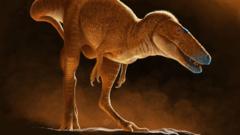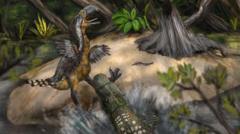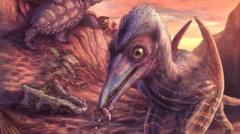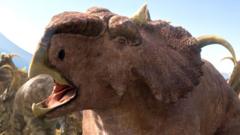Researchers have identified a new ancestor of the tyrannosaurus, Khankhuuluu mongoliensis, from fossils discovered in Mongolia, prompting a reevaluation of the evolutionary history of these iconic predators. This discovery highlights the evolutionary transition from smaller, fleet-footed species to formidable giants like T.rex, melting previously held assumptions about their development.
New Dinosaur Species Khankhuuluu mongoliensis Discovered, Altering Tyrannosaur Evolution Narrative

New Dinosaur Species Khankhuuluu mongoliensis Discovered, Altering Tyrannosaur Evolution Narrative
A recently unearthed species, Khankhuuluu mongoliensis, suggests a significant evolutionary shift in the tyrannosaur lineage, challenging existing beliefs about their ancestry.
Scientists have made a groundbreaking discovery in the fossil records, identifying a new species of dinosaur named Khankhuuluu mongoliensis, which could reshape our understanding of the tyrannosaur family tree. The fossils, housed in a Mongolian museum, are thought to belong to the closest known ancestor of all tyrannosaurs, the group that includes T.rex among its most notorious members.
The findings were published in the journal Nature and reveal that the two skeletons studied, dating back 86 million years, represent not just another species, but a critical piece in understanding the evolutionary journey of these ancient predators. The name Khankhuuluu, which translates to “Dragon Prince of Mongolia,” reflects its position as an early and smaller tyrannosauroid. Prof. Darla Zelenitsky from the University of Calgary stated that this name signifies a transition phase, emphasizing how early tyrannosaurs, once small, turned into the powerful predators that would dominate ecosystems.
PhD student Jared Voris, who led the research, explained the significance of this evolution, noting that Khankhuuluu weighed about 750kg—an impressive figure, though still significantly smaller than adult T.rex, which could weigh up to eight tons. This transitional fossil depicts the evolutionary steps that led to the development of crucial anatomical features, particularly in skull and jaw structure, which enabled later tyrannosaurs to break bone and hunt larger prey effectively.
The fossils were initially discovered over forty years ago but were misidentified as belonging to another species, Alectrosaurus. However, further analysis by Mr. Voris revealed distinct tyrannosaur-like characteristics, resulting in a new classification that has the potential to rewrite the existing narrative around tyrannosaur evolution. This alteration is also supported by the knowledge that these dinosaurs were adept at migrating between North America and Asia via land bridges, which facilitated varied evolutionary paths through different ecological niches.
This remarkable discovery advocates for the importance of small, incremental evolutionary steps, illustrating how the path of tyrannosaurs transitioned from “princes” in their youth to the apex predators known today.










